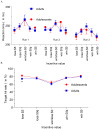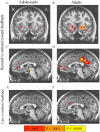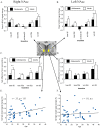Adolescents, adults and rewards: comparing motivational neurocircuitry recruitment using fMRI
- PMID: 20625430
- PMCID: PMC2897849
- DOI: 10.1371/journal.pone.0011440
Adolescents, adults and rewards: comparing motivational neurocircuitry recruitment using fMRI
Abstract
Background: Adolescent risk-taking, including behaviors resulting in injury or death, has been attributed in part to maturational differences in mesolimbic incentive-motivational neurocircuitry, including ostensible oversensitivity of the nucleus accumbens (NAcc) to rewards.
Methodology/principal findings: To test whether adolescents showed increased NAcc activation by cues for rewards, or by delivery of rewards, we scanned 24 adolescents (age 12-17) and 24 adults age (22-42) with functional magnetic resonance imaging while they performed a monetary incentive delay (MID) task. The MID task was configured to temporally disentangle potential reward or potential loss anticipation-related brain signal from reward or loss notification-related signal. Subjects saw cues signaling opportunities to win or avoid losing $0, $.50, or $5 for responding quickly to a subsequent target. Subjects then viewed feedback of their trial success after a variable interval from cue presentation of between 6 to 17 s. Adolescents showed reduced NAcc recruitment by reward-predictive cues compared to adult controls in a linear contrast with non-incentive cues, and in a volume-of-interest analysis of signal change in the NAcc. In contrast, adolescents showed little difference in striatal and frontocortical responsiveness to reward deliveries compared to adults.
Conclusions/significance: In light of divergent developmental difference findings between neuroimaging incentive paradigms (as well as at different stages within the same task), these data suggest that maturational differences in incentive-motivational neurocircuitry: 1) may be sensitive to nuances of incentive tasks or stimuli, such as behavioral or learning contingencies, and 2) may be specific to the component of the instrumental behavior (such as anticipation versus notification).
Conflict of interest statement
Figures








References
-
- Castellanos FX, Lee PP, Sharp W, Jeffries NO, Greenstein DK, et al. Developmental trajectories of brain volume abnormalities in children and adolescents with attention-deficit/hyperactivity disorder. Jama. 2002;288:1740–1748. - PubMed
-
- Giedd JN, Blumenthal J, Jeffries NO, Castellanos FX, Liu H, et al. Brain development during childhood and adolescence: a longitudinal MRI study. Nat Neurosci. 1999;2:861–863. - PubMed
-
- Sowell ER, Thompson PM, Holmes CJ, Jernigan TL, Toga AW. In vivo evidence for post-adolescent brain maturation in frontal and striatal regions. Nat Neurosci. 1999;2:859–861. - PubMed
-
- Durston S, Hulshoff Pol HE, Casey BJ, Giedd JN, Buitelaar JK, et al. Anatomical MRI of the developing human brain: what have we learned? J Am Acad Child Adolesc Psychiatry. 2001;40:1012–1020. - PubMed
Publication types
MeSH terms
Grants and funding
LinkOut - more resources
Full Text Sources
Medical
Miscellaneous

